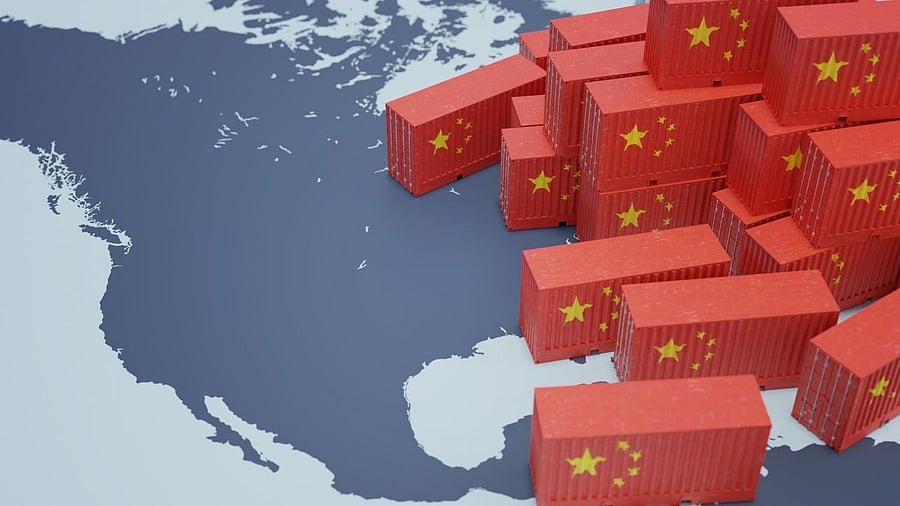
Representative illustration showing shipping containers with the flag of China.
Credit: iStock Photo
As the US-China trade war intensifies, its newest casualty is the global supply of rare earth elements (REEs). These are a group of 17 minerals that are critical inputs in the manufacturing of a vast array of technologies, from electric vehicles and smartphones to semiconductors and advanced weapons systems.
In April 2025, China’s Ministry of Commerce placed export restrictions on medium and heavy rare earth elements and their derivative magnets in retaliation for the 145% US tariffs on Chinese goods imposed by the Trump administration. The restrictions apply to seven rare earths: samarium, gadolinium, terbium, dysprosium, lutetium, scandium, and yttrium. These commodities constitute a tiny share of China’s overall exports to the US, so halting shipments causes minimal economic pain to China while having outsized effects abroad.
This move is the latest in a series of tit-for-tat weaponisations of supply chains between China and the US. However, China holds a unique advantage in this conflict. Its near-monopoly on rare earths—producing 60% of the world’s supply and processing nearly 90%—gives it an unparalleled edge. Until 2023, China accounted for 99.9% of heavy REE processing. A single refinery in Vietnam, Vietnam Rare Earth JSC, accounted for the rest. However, the facility has been out of operation for the past year due to a tax dispute, granting China an absolute monopoly over supply. China also accounts for around 90% of global rare earth magnet production. Other countries like Japan and Germany produce much of the remainder, but they are still dependent on China for raw materials.
China has been leveraging its dominance in this industry as geopolitical capital since 2010, when it banned exports to Japan during the Senkaku Islands dispute. In 2022, the US launched the CHIPS Act to curb China’s access to advanced semiconductor technology, and once again, minerals became a central tool in Beijing’s counterstrategy. Between 2023 and 2025, China imposed restrictions on exporting strategic materials to the US, including gallium, germanium, antimony, graphite, and tungsten. It also announced a ban on rare earth extraction and separation technologies to hamper the development of REE supply chains outside China.
This dominance in the rare earth supply chain did not emerge overnight. It is the result of decades of strategic government policies and investment. As early as 1992, then Chinese paramount leader Deng Xiaoping famously stated, “The Middle East has oil and China has rare earths.” Beijing prioritised the development of its rare earth mining and processing industry and was able to undercut global competitors due to lower environmental standards and labour costs. It also employed export restrictions to boost its domestic industry, with the World Trade Organization ruling against it in 2014 for distorting global markets.
The restrictions implemented in April 2025 require firms to apply for a licence to export rare earths. These may temporarily pause Chinese exports while the Beijing government sets up the requisite licensing system, creating space for countries to cooperate with China to prevent disruptions to their REE supplies. China also placed 16 American entities on its export control list, limiting their access to dual-use goods. This strategy of using licensing, rather than outright bans, enables China to flex its muscles without completely severing trade.
These restrictions do not include the more abundant light rare earths like neodymium and praseodymium. China retains the option to use these to escalate further if trade tensions continue to rise. In the past, economic self-interest tempered threats to restrict exports, but Beijing now appears more willing to leverage its rare earth dominance—even at the cost of disrupting its own supply chains.
The impact of the halt in supply will vary across countries. For instance, Japanese companies took steps to insulate themselves by building stockpiles of REEs after the seven-week embargo in 2010. However, American companies have not, due to just-in-time business models and high storage costs. Indian supply chains are unlikely to face immediate fallout from the restrictions because of a relatively low volume of imports. While the Indian government has pushed to boost domestic semiconductor and defence equipment manufacturing, these projects are still nascent, and the more advanced manufacturing stages typically occur abroad. This will shield the country in the short term, but it may have indirect effects on the availability of finished products.
However, Chinese export curbs may trigger a global scramble for alternative sources, creating an opportunity for India and others to fill the market gap. There are substantial global reserves of REEs outside China, including 19% in Vietnam, 18% in Brazil, 6% in India, and 4% in Australia. Yet the switch will not be easy. These countries currently lack the specialised technical expertise that China possesses. Developing capabilities for separation, processing, and manufacturing is highly cost-intensive, and the present global climate of extreme regulatory uncertainty further undermines the investment environment. Moreover, establishing such facilities and scaling production to economically viable levels will take several years. For China, given its economies of scale, it makes commercial sense, but it may be a formidable challenge for many other countries.
In the short term, China holds an unshakeable chokehold on the global rare earths industry. It is wielding this leverage in the current geoeconomic contest by framing it within national security concerns—just as the US has done with semiconductors. Despite the threat being well understood for years, the price advantage of sourcing from China has hindered domestic development elsewhere. For India and other countries, this moment underscores the urgent need to build resilient supply chains as a matter of national security and sovereignty. China has demonstrated their utility as a tool of geopolitical influence. Now, the race to secure these critical resources will shape not only the future of global trade but also the balance of technological and strategic power in the years ahead.
(Sameer Patil is the Director of Centre for Security, Strategy and Technology at the Observer Research Foundation. Amoha Basrur is a Junior Fellow at CSST, ORF)